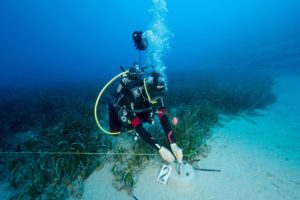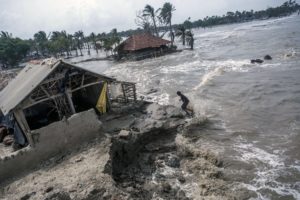As climate change and nature loss are interrelated crises, financial institutions and policymakers must account for both. Yet climate and nature investments that benefit both – such as restoring carbon-rich ecosystems – have so far received the least money and attention.
Nature-related risks, including but not limited to a deepening biodiversity crisis, are growing at an alarming pace, as is the urgency of the climate crisis, with growing implications for financial systems.
To date, however, attention within the policy community and the financial system has largely focused on climate. This focus is warranted as climate change represents a threat to lives and livelihoods the scale of which can hardly be overstated.
The Taskforce on Climate-related Financial Disclosures (TCFD), for example, combined with recent regulatory requirements, has ushered in much stronger climate-related risk assessment practices among financial institutions and their investees globally, forcing them to scrutinise more carefully their contribution to climate change and a low-carbon transition.
However, this focus has overwhelmed the emergence of other environmental and social risks, including massive and accelerating biodiversity losses, with more than 1 million species at risk of extinction worldwide, according to IPBES, the UN biodiversity panel. These risks have important implications for a variety of economic sectors that are directly reliant on natural inputs, including agriculture, fishing, and downstream food processing. Even sectors more removed from natural inputs are not free of nature-related risk. For example, the impact of clearing land for agriculture can increase soil erosion and reservoir sedimentation, which can exacerbate flooding, leading to large accumulated impacts on companies’ financial performance and financial institutions’ portfolios.
There are early signs that financial institutions are starting to consider nature-related risks to their balance sheets, including the first biodiversity-related financial stability analysis conducted by the Dutch Central Bank, as well as the launch of the Interim Working Group on nature-related financial risks that will ultimately lead to a Task Force on Nature-related Financial Disclosure (TNFD), with a broadly similar remit to the TCFD.
Despite the positive signs, the mainstream financial community does not yet take account of its impacts and reliance upon nature. Financial institutions often argue that nature-related risks are a subset of those posed by climate, and so managing climate risk is sufficient. Other common arguments are that managing climate risk has taken up all their capacity, leaving no bandwidth to account for nature risks, or that the data, tools and approaches required to manage nature-related risks do not yet exist.
While these perspectives represent a legitimate concern about capacity and priorities, they are largely founded on misconceptions that slow the pace at which nature risks are factored into financial decisions.
Taking action
Nature risks are too urgent and too impactful to delay action, and the global community of experts, policymakers and financial sector leaders must find ways to meet both challenges efficiently. Solutions can mitigate both crises, but only if stakeholders have a clear understanding of how the crises interact.
We can divide actions on climate change and nature into categories according to how they interact:
- actions that benefit both nature and climate;
- that target nature but have climate co-benefits;
- that target climate with nature co-benefits;
- and those that benefit climate but harm nature.
Ultimately, meeting the climate change and nature challenges will require action across all these categories, and finding solutions will reduce the financial risks throughout the system.
To date, solutions across all four categories remain underinvested relative to estimates of what is required to stabilise risk levels throughout the financial system. Continued underinvestment will dramatically increase both climate and nature risks, as has been demonstrated emphatically in reporting by the UN climate and biodiversity panels (the IPCC and IPBES).
Worse, least invested of all are the most efficient solutions, from a combined nature and climate perspective. This is because current investment in solutions heavily favours climate.
Nature risks are too urgent and too impactful to delay action
An analysis of nature investment estimates, produced by recent research led by the Paulson Institute, suggests that actions that benefit climate change at the expense of nature – the fourth category – are attracting over half of the investment they need. These actions include investment in bioenergy, and bioenergy with carbon capture and storage, or large mass transit infrastructure projects. Some of these projects may ultimately be necessary for the low-carbon transition to limit global average temperature rise to no more than 2C, but they must be undertaken judiciously and managed in a way that minimises their nature footprint.
In contrast, category 1 actions, which benefit both climate and biodiversity, are only attracting roughly 8% of their identified investment need, implying that the financial sector’s focus on climate is resulting in inefficient allocation of capital. This category includes actions such as the protection, restoration and expansion of carbon-dense natural ecosystems that both sequester greenhouse gases and provide natural habitats benefiting wildlife, as well as offering a variety of other ecosystem services. These terrestrial and marine nature-based solutions represent efficient win-win solutions.
Other efficient solutions include our category 2 actions, which primarily benefit nature with indirect climate impacts, such asinterventions that reduce pesticides and nitrogen inputs on farms. These benefit insects and soil biodiversity, but also cut greenhouse gas emissions and enhance the resilience of crop yields to climate change.
Our category 3 actions, which benefit climate with indirect nature impacts, includerenewable power and electric vehicles that reduce carbon emissions, and in turn improve outcomes for nature, given that climate change is a growing driver of biodiversity loss.
Continuing to pursue action on disconnected tracks risks wasting resources and producing sub-optimal outcomes both for biodiversity and by implication for financial institutions and their investees, where these depend on that biodiversity, or where they fall foul of tightening regulations to protect nature.
Substantial benefits are achievable from managing climate and nature investments by focusing on actions that can support sustainable transitions in both areas. For example, institutions can invest in supply chain and investee due diligence, to measure both their biodiversity-related and climate risk exposure. In so doing, they will find dealing with emerging risks much easier, and the additional capacity requirements associated with nature-related risk less onerous. The ability to navigate the linked transitions towards sustainable investments in climate and nature will be a defining attribute of the institutions that are most financially resilient in the next decade and beyond.









